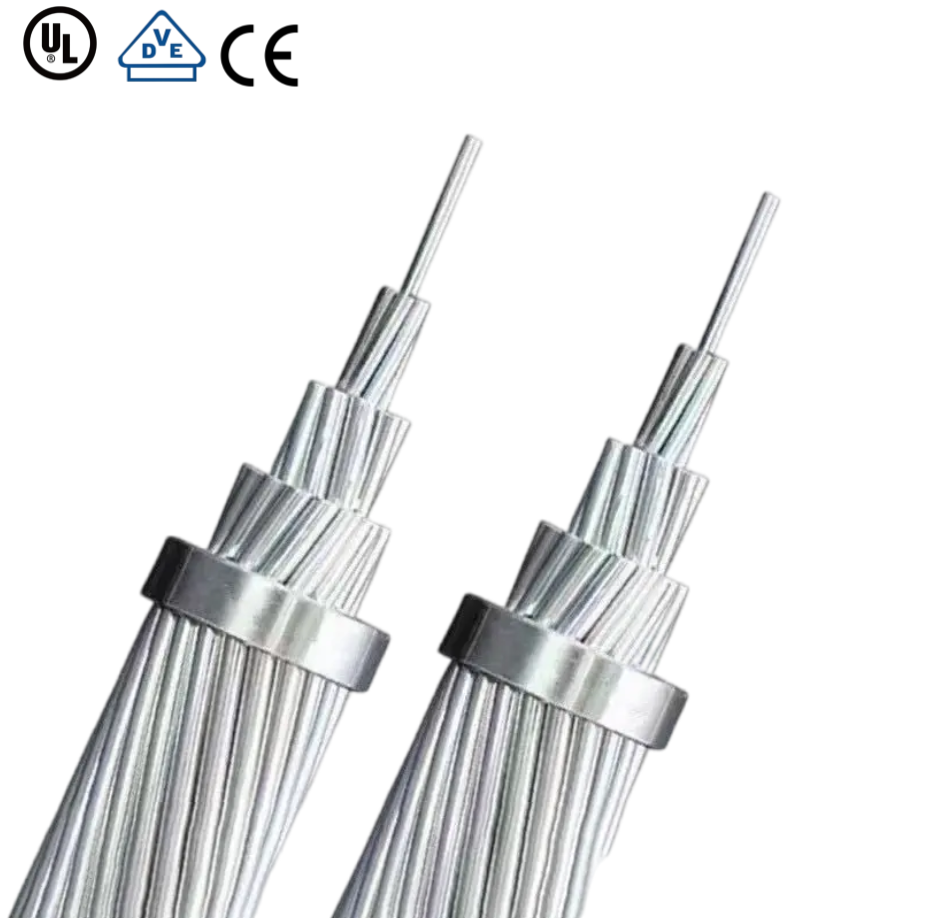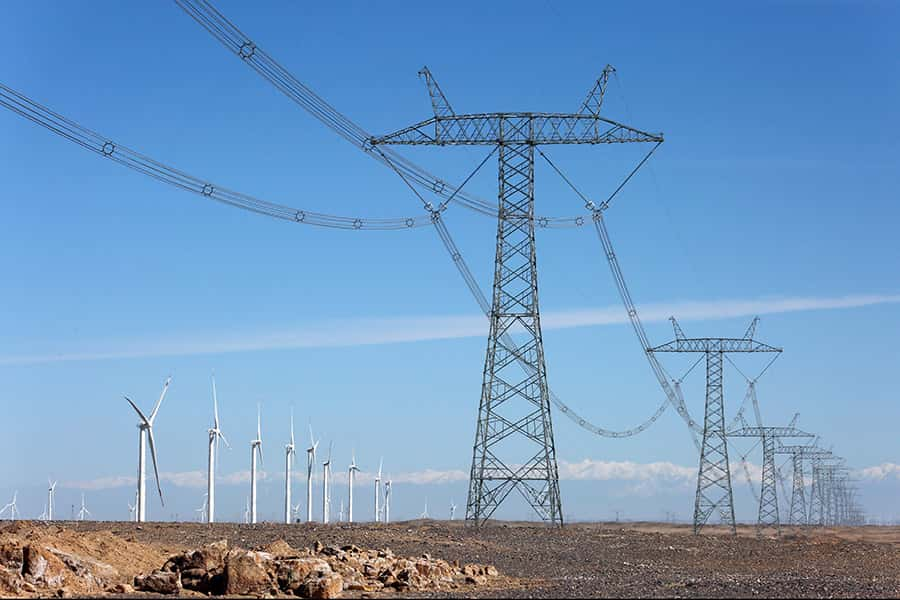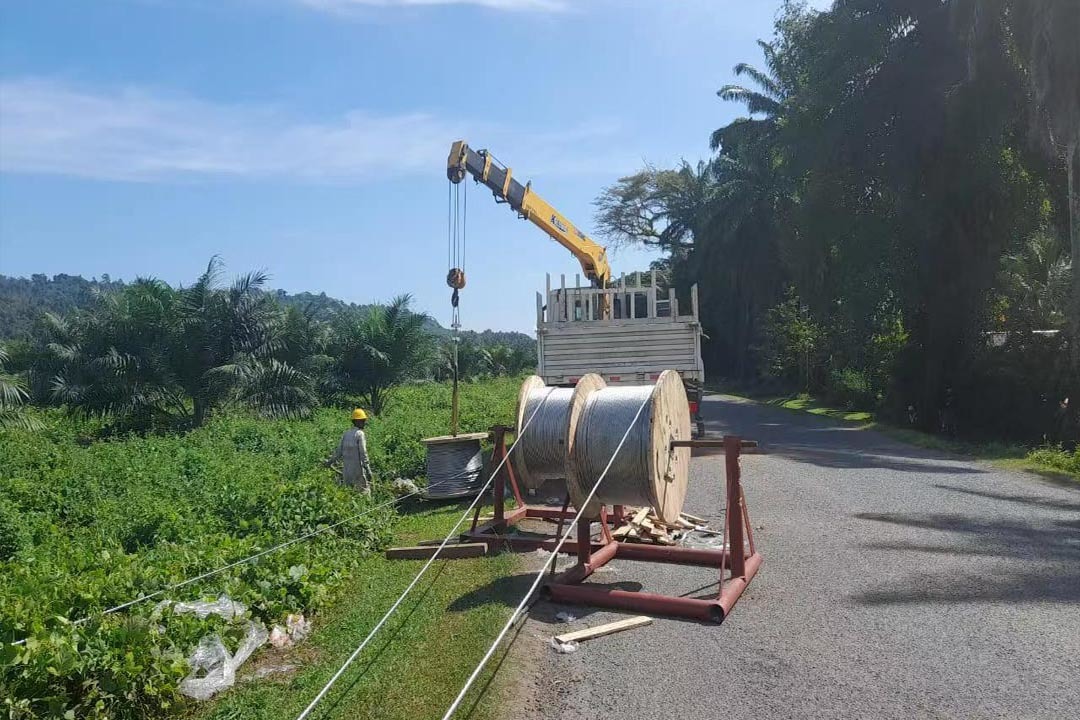
A Deep Dive into All-Aluminum Conductors: AAC, AAAC, and ACSR Explained
2025-08-01
A Comprehensive Analysis of Bare Aluminum Wire: Characteristics, Applications, and International Standards
As a fundamental material in power transmission and electrical equipment manufacturing, bare aluminum wire plays a vital role in modern industry. This article will begin with the basic concepts of bare aluminum wire and discuss in detail its physical properties, production processes, applications, domestic and international standards and specifications, and selection considerations, providing a comprehensive understanding of this important conductive material. Whether you are a power engineer, electrical equipment manufacturer, or student in related fields, this article will provide you with a comprehensive understanding of bare aluminum wire.
Basic Concepts and Characteristics of Bare Aluminum Wire



Bare aluminum wire refers to pure aluminum or aluminum alloy conductors without insulation. It is widely used in power transmission, motor windings, and various electrical equipment. Compared to insulated wire, bare aluminum wire is directly exposed to the environment and relies on air as an insulating medium, which gives it unique performance characteristics and application scenarios.
From a material perspective, bare aluminum wire offers several significant advantages. Aluminum's electrical conductivity is second only to silver and copper. While its conductivity is approximately two-thirds that of copper, its density is only one-third (aluminum density is 2.703 g/cm³, copper density is 8.89 g/cm³). This means that to transmit the same amount of electricity, aluminum wire requires only half the mass of copper wire.6This characteristic gives bare aluminum wire a distinct advantage in long-span overhead lines. Furthermore, the naturally formed oxide film on the aluminum surface not only provides a certain degree of corrosion resistance but also offers slight insulating properties, further expanding its application in the electrical field.
The resistivity of bare aluminum wire is a key parameter, with high-quality bare aluminum wire boasting a resistivity of no more than 0.02801 Ω·mm²/m². This parameter directly impacts line transmission efficiency and heat generation, making it a crucial consideration in engineering design and selection. Bare aluminum wire is typically produced in sizes ranging from 7 mm² to 300 mm², with a variety of product forms, including flat wire, square wire, special-shaped wire, and ultra-thin wire.6 Extruded bare aluminum wire boasts a smooth surface, free of burrs and oil stains, uniform softness, and low resistivity. This significantly improves the backup capacity, reliability, and safety of electrical products, extending their service life.
The melting point of bare aluminum wire is 658.7°C, lower than copper's 1083°C. This characteristic requires special consideration in high-temperature environments.
In practical applications, the normal operating temperature of conventional steel-core aluminum stranded wire is 70°C. However, using heat-resistant aluminum alloy conductors can increase this temperature to 150°C, increasing the current carrying capacity of the same specification by 1.6 times.
This improved heat resistance makes it possible to increase transmission capacity without replacing existing towers, significantly reducing line modification costs.
From a mechanical perspective, pure aluminum wire has relatively low strength, which is a key reason for the development of various aluminum alloy wires and composite conductors (such as steel-core aluminum stranded wire). By adjusting the alloy composition or adopting a composite structure, the mechanical strength of bare aluminum wire can be significantly improved to meet the needs of different application scenarios.
Bare Aluminum Wire Types and Product Classifications
Bare aluminum wire can be categorized into several types based on its structure and material composition, each with its own specific application scenarios and performance characteristics. Understanding these classifications will help you select the most appropriate product for your project.
Bare aluminum stranded wire (LJ) is the most basic type, consisting of multiple strands of aluminum wire. It offers advantages such as low specific gravity and low price, and its electrical conductivity is second only to copper, but its mechanical strength is relatively low. This type of wire is suitable for general distribution lines, but caution should be exercised when used in environments requiring high mechanical strength or in corrosive environments. The standard designation for bare aluminum stranded wire in China is LJ, and cross-sections typically range from 16 to 800 mm².
Aluminum stranded steel wire (SSC) is one of the most commonly used types in power transmission, combining the high strength of steel with the excellent electrical conductivity of aluminum. This type of wire features several layers of aluminum strands wrapped around an inner core of steel strands (typically one or seven strands). The steel core bears the primary mechanical stress, while the aluminum strands transmit the electrical energy. Steel-core aluminum stranded wire is designated as LGJ in China. For example, LGJ-400/35 is commonly used in 500 kV transmission lines, where 400 represents an aluminum cross-section of 400 square millimeters and 35 represents a steel core cross-section of 35 square millimeters. Based on the cross-sectional area ratio of the aluminum to steel wire, steel-core aluminum stranded wire is divided into standard (ratio 5.2-6.1), reinforced (ratio 4-4.5), and lightweight (ratio 7.6-8.3).
Aluminum alloy stranded wire is another important type, containing approximately 98% aluminum with trace amounts of magnesium, silicon, and iron. Its density is similar to that of pure aluminum, with slightly lower electrical conductivity (approximately 10%), but its mechanical strength is approximately double that of aluminum stranded wire of the same cross-section. 48 Aluminum alloy stranded wire primarily includes heat-treated aluminum-magnesium-silicon alloy wire (LHAJ) and heat-treated aluminum-magnesium-silicon rare earth alloy wire (LHBJ). 4 However, aluminum alloy wire has poor vibration resistance, making it unsuitable for use in long-span overhead lines.
Quality control is rigorous throughout the entire bare aluminum wire production process. From chemical composition analysis of aluminum rods, dimensional accuracy and surface inspection of individual wires, to structural parameters and performance testing of stranded wires, each step is subject to stringent standards and testing methods. Bare aluminum wire for high-voltage transmission, in particular, requires additional performance testing, such as corona testing, creep testing, and fatigue testing, to ensure long-term reliability under various environmental conditions.
Modern bare aluminum wire production is also increasingly focused on environmental protection and energy conservation. Aluminum recycling plays a crucial role in the industry. The rational use of recycled aluminum not only reduces costs but also energy consumption and environmental impact. Furthermore, energy consumption control and waste recycling during the production process are also key areas of technological development in the industry. Extruded bare aluminum wire boasts a smooth, burr-free, oil-free surface, uniform softness, and low resistivity, making it an ideal choice for producing aluminum magnet wires such as glass-fiber-wrapped, paper-wrapped, and film-wrapped wires.
As the power industry continues to demand ever-increasing transmission capacity and efficiency, bare aluminum wire production processes are undergoing continuous innovation. The development of new alloys, composite structural designs, and the application of intelligent production equipment are driving the development of bare aluminum wire products towards higher performance, greater reliability, and greater cost-effectiveness.
Analysis of Bare Aluminum Wire Applications and Scenarios
Due to its excellent conductivity, lightweight, and cost-effectiveness, bare aluminum wire plays an important role in multiple industrial sectors. Understanding the different application scenarios of bare aluminum wire helps to make appropriate selections and designs in practical projects.
Power transmission is the primary application of bare aluminum wire. High-voltage overhead transmission lines generally use aluminum stranded steel conductor (ACSR) as conductors. Common models for China's 500 kV transmission lines include LGJ-400/353. The main reasons for using bare aluminum wire for high-voltage transmission include: the high voltage (hundreds of kilovolts) and low current transmission methods minimize the impact of aluminum wire's higher resistivity; overhead lines are located at high altitudes, out of reach of humans and animals, and therefore do not require insulation protection; and the lightweight nature of aluminum wire makes it particularly suitable for long-span installations, significantly out of reach of copper wire. In the ultra-high voltage transmission sector, expanded-diameter conductors such as JLHN58K-1600 are used for their ability to effectively reduce corona losses and electromagnetic interference.1 Split conductors (using multiple conductors per phase) are also a common technology for high-voltage transmission. Lines of 330 kV and above often use two-, three-, four-, or even eight-split conductors. Some 220 kV lines also use double-split conductors to increase transmission capacity.
In distribution systems, bare aluminum stranded wire (LJ) is commonly used for overhead distribution lines at lower voltage levels. However, due to aluminum's poor corrosion resistance, bare aluminum stranded wire is not suitable for installation in chemical and coastal areas. For distribution lines with special requirements, such as long spans or corrosive environments, specialized bare aluminum wires such as aluminum-clad steel stranded wire or heat-resistant aluminum alloy conductors can be used. Aluminum-clad steel stranded wire consists of a single steel core covered with an aluminum layer, creating a multi-stranded conductor with good mechanical strength and a certain degree of conductivity.8 Heat-resistant aluminum alloy conductors, such as NRLH58GJ, can operate at temperatures up to 150°C and carry 1.6 times the current of conventional conductors, making them particularly suitable for line reconstruction projects requiring increased capacity.
Electrical equipment manufacturing is another important application area for bare aluminum wire. Bare aluminum wire is used as a conductive material in the manufacture of motors, welding machines, transformers, and in the installation and distribution of electrical equipment. In motor and transformer windings, bare aluminum wire serves as the base material for aluminum magnet wires such as glass-fiber-wrapped wire, paper-wrapped wire, and film-wrapped wire. Round 3/4-inch hard bare aluminum wire is commonly used in motors and instruments. Its characteristics are governed by specific international standards, such as NF C31-122-1980. Bare aluminum wire is used in electrical equipment manufacturing due to its excellent conductivity, moderate mechanical properties, and low cost. Extruded bare aluminum wire, in particular, offers a smooth, burr-free, oil-free surface, uniform softness, and low resistivity. This improves the backup capacity, reliability, and safety of electrical products, extending their service life.
Specialized bare aluminum wire is widely used in electrified transportation systems. Overhead contact wires (commonly known as tram wires) are used in electrified railways, urban trams, and electric locomotives in tunnels (such as subways and underground mines). These conductors require extremely high wear resistance, which directly affects their service life. Copper or copper alloys are typically used, but aluminum or aluminum alloys are also used in certain applications. Contact wires must possess excellent electrical properties, sufficient tensile strength, and excellent weathering, corrosion, and wear resistance. With the development of urban rail transit and electrified railways, the use of contact wires has increased significantly, driving advancements in related bare wire technology.
Bare aluminum wire also finds a place in specialized industrial applications. High-purity aluminum wire (aluminum content above 99.9%) is used in high-end applications such as electronics, vacuum coating, and aluminum-coated paper. Ordinary aluminum wire (aluminum content below 99.9%) is used in the manufacture of wires, cables, motors, and electrical appliances, as well as for rivets and welding. Aluminum alloy wire has specialized applications in the electronics and textile sectors and can also be used as wire, cable, rivets, and solder. In substations, bare aluminum busbars serve as high-current busbars (busbars). These are typically flat, but also come in hollow rectangular and semi-bow shapes. They are used to transmit high-capacity currents and connect switchgear.
It's worth noting that while bare aluminum wire is widely used in power transmission and industrial applications, it's not suitable for home decoration. Home wiring is often buried within walls and uses a low-voltage (220V) high-current power supply. The high resistance of aluminum wire can cause significant heat generation, potentially burning the insulation and causing short circuits or fires. Furthermore, the connection between aluminum wire and copper terminals is prone to electrochemical corrosion, increasing contact resistance and posing safety risks. Therefore, copper wire is essential for home decoration. Although aluminum wire was used in welfare housing provided by work units over 30 years ago, this has now been gradually replaced.
With technological advances, the application areas of bare aluminum wire are continuously expanding. The development of new conductors, such as carbon fiber composite core conductors, has opened up new possibilities for the use of bare aluminum wire in challenging environments, such as high temperatures, strong winds, and heavy ice. At the same time, performance optimization and cost control of existing bare aluminum wire products have helped them maintain their competitiveness in traditional applications. In the future, with the large-scale development of smart grids and new energy sources, bare aluminum wire technology will face new opportunities and challenges.
Comparison of Domestic and International Bare Aluminum Wire Standards and Specifications
The production and application of bare aluminum wire adhere to a strict standard system, with different countries and regions formulating their own technical specifications. Understanding these differences is crucial for product design, international trade, and engineering applications.




China's national standards provide systematic regulations for bare aluminum wire. GB/T 1179-2008, "Round Wire Concentric Stranded Overhead Conductors," is the current core standard, replacing the earlier GB1179-83, "Aluminum Stranded Wire and Steel-Reinforced Aluminum Stranded Wire." The new standard changes the aluminum stranded wire model designation from LJ to JL, and covers a wider range of product specifications from 10 to 1500 mm².1 Steel-reinforced aluminum stranded wire is designated as JL/G1A, JL/G1B, JL/G2A, JL/G2B, and JL/G3A, with a cross-section range of 16 to 1440 mm².1 Chinese standards provide detailed specifications for the structural parameters, mechanical properties, electrical properties, and test methods of bare aluminum wire, serving as the basis for design, production, and acceptance. For example, the enterprise standard Q/09TDL030-2007 for heat-resistant aluminum alloy conductors specifies technical requirements for models NRLH58GJ and NRLH58J.
American Society for Testing and Materials (ASTM) standards have a wide international influence. ASTM B231 specifies the technical requirements for aluminum conductor (AAC, All Aluminum Conductor), while ASTM B232 addresses aluminum conductor steel-reinforced (ACSR, Aluminum Conductor Steel Reinforced). Model designations in US standards are concise and clear, such as AAC for all-aluminum conductor and ACSR for aluminum conductor steel-reinforced. ACSR/AS is also a common designation for aluminum conductor steel-reinforced. US standards place particular emphasis on mechanical properties and dimensional tolerances, and their test methods differ from Chinese standards, requiring special consideration when collaborating on international projects and exporting products.
The specifications for bare aluminum wire in the European standard system each have their own distinct characteristics. The German DIN 48201 standard provides detailed regulations for aluminum stranded wire and steel-reinforced aluminum stranded wire. The British BS 215 standard is also a widely adopted technical specification in Europe.1 European standards generally have higher environmental performance requirements for materials, and restrictions on certain hazardous substances are more stringent than those in China and the United States. The French standard NF C31-122-1980 specifically addresses round 3/4 hard bare aluminum wire for motors and instruments, detailing the characteristics of this special-purpose conductor. The European standards system is characterized by detailed classification, with specialized product standards for different application scenarios.
The International Electrotechnical Commission (IEC) standards aim to harmonize international differences and facilitate international trade. The bare aluminum wire specifications in the IEC standards are used by many countries as the basis for their own standards. IEC 61089 specifies general requirements for round concentrically stranded overhead conductors, covering types such as AAC, AAAC (all-aluminum alloy conductor), and ACSR.
Quick Quote
* Note: Please be sure to fill in the information accurately and keep the communication open. We will get in touch with you as soon as possible

Copyright © 2023 Shandong Zhongmai Cable Co., Ltd

